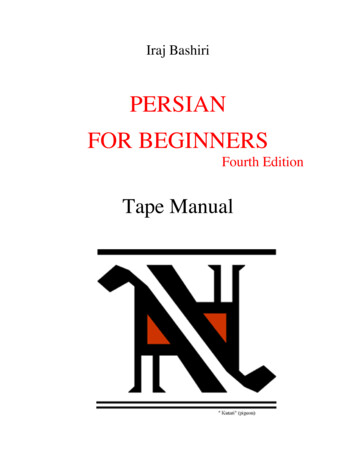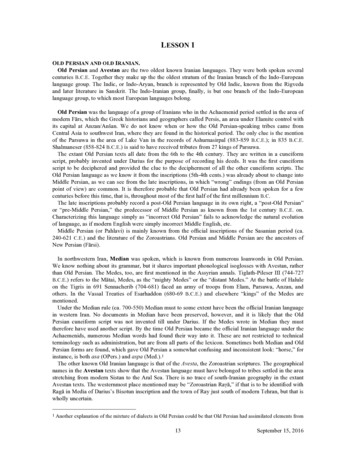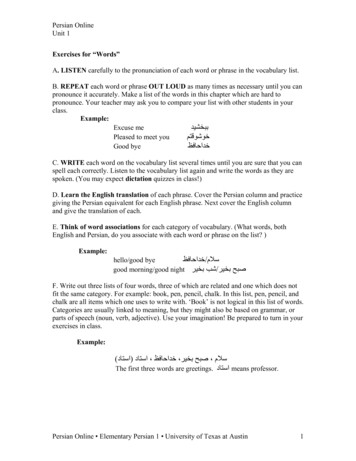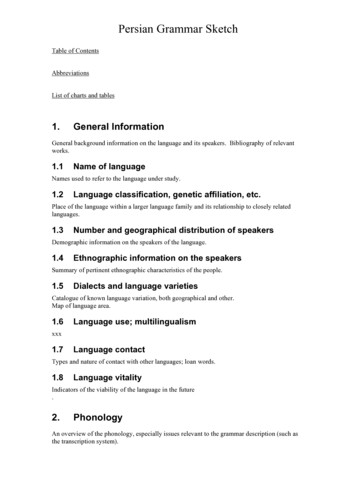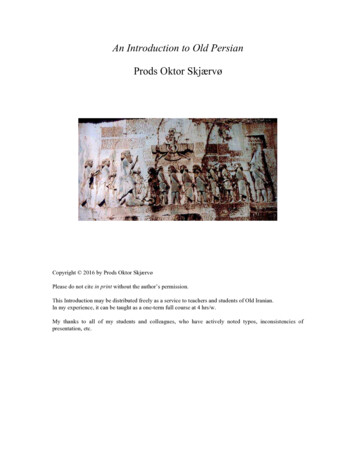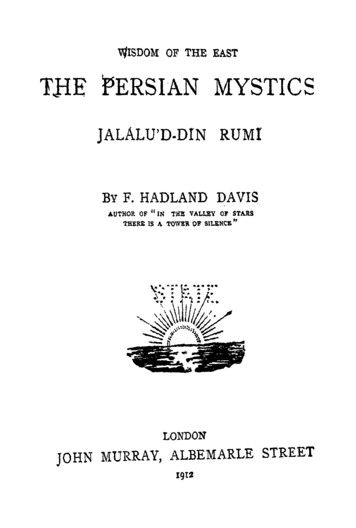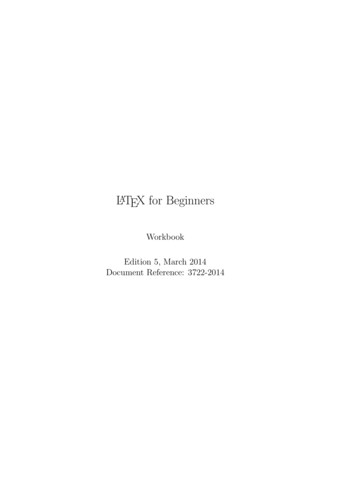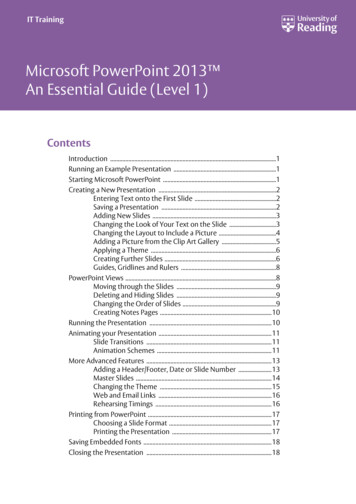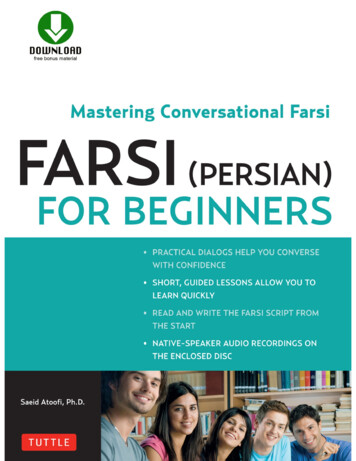
Transcription
2
3
DEDICATIONFor Sofia, my daughter living in three worlds. May you be the link: logos, pathos, and mythos4
ACKNOWLEDGMENTI would like to express my gratitude to many people who helped me with this book. My sister Ameneh (Maliheh) Atoofiwho patiently and meticulously proofread the manuscript many times, provided me with valuable advice on contents, andorganized many other aspects such as photos and sound files. Of course, I am indebted to other members of my family forthe creation of this book, some with their wonderful photographic skills (Donya and Majid), and others with the sound filesand advice (Nahid, Haydeh, Homyra, Davood, Mehran, Baran, Bahareh, Majid, Donya, Diba, Banafsheh, Azadeh, andMarjan). I have been very fortunate to be around wonderful people who constantly encouraged me and gave me moralsupport in this project: my soulmate Viviana and my best of friends and family, Marjan Shokri and Alireza Keshvari. Iwould also like to thank my editors and reviewers for their wonderful comments and suggestions. It has been great learningfrom the masters.5
Saeid Atoofi, Ph.D.Content Advisor:Maliheh (Ameneh) AtoofiTUTTLE PublishingTokyo Rutland, Vermont Singapore6
The Tuttle Story: “Books to Span the East and West”Many people are surprised to learn that the world’s leading publisher of books on Asia had humble beginnings in the tiny American state of Vermont. Thecompany’s founder, Charles E. Tuttle, belonged to a New England family steeped in publishing.Immediately after WWII, Tuttle served in Tokyo under General Douglas MacArthur and was tasked with reviving the Japanese publishing industry. He laterfounded the Charles E. Tuttle Publishing Company, which thrives today as one of the world’s leading independent publishers.Though a westerner, Tuttle was hugely instrumental in bringing a knowledge of Japan and Asia to a world hungry for information about the East. By the timeof his death in 1993, Tuttle had published over 6,000 books on Asian culture, history and art—a legacy honored by the Japanese emperor with the “Order of theSacred Treasure,” the highest tribute Japan can bestow upon a non-Japanese.With a backlist of 1,500 titles, Tuttle Publishing is more active today than at any time in its past—still inspired by Charles Tuttle’s core mission to publish finebooks to span the East and West and provide a greater understanding of each.7
Published by Tuttle Publishing, an imprint of Periplus Editions (HK) Ltd.www.tuttlepublishing.comCopyright 2015 by Saeid AtoofiAll rights reserved. No part of this publication may be reproduced or utilized in any form or by any means, electronic or mechanical, including photocopying,recording, or by any information storage and retrieval system, without prior written permission from the publisher.Library of Congress Control Number: 2015940721ISBN 978-0-8048-4182-5ISBN 978-1-4629-1424-1 (ebook)Distributed byNorth America, Latin America & EuropeTuttle Publishing364 Innovation DriveNorth Clarendon,VT 05759-9436 U.S.A.Tel: 1 (802) 773-8930Fax: 1 (802) ing.comJapanTuttle PublishingYaekari Building, 3rd Floor,5-4-12 OsakiShinagawa-ku, Tokyo 141 0032Tel: (81) 3 5437-0171Fax: (81) 3 5437-0755sales@tuttle.co.jpwww.tuttle.co.jpAsia PacificBerkeley Books Pte. Ltd.61 Tai Seng Avenue #02-12,Singapore 534167Tel: (65) 6280-1330Fax: (65) First edition18 17 16 15 5 4 3 2 1 1505MPPrinted in SingaporeTUTTLE PUBLISHING is a registered trademark of Tuttle Publishing, a division of Periplus Editions (HK) Ltd.8
ContentsTo the LearnerIntroductionHow to Use This BookTransliteration ConventionsFarsi ScriptsChapter 1Greetings1.1 Conversation: Meeting the Rahmatis1.2 Formal vs Colloquial: Words from the Conversation1.3 Let’s Talk1.4 The Letters Alef, Lām, Sin, and Mim1.5 Let’s Write1.6 Cultural Insight: Emotional Expressions1.7 Vocabulary1.8 Grammar Point: The Verb (to be) Boodan1.9 Poem1.10 ExercisesChapter 2Transportation2.1 Conversation: In the Taxi2.2 Formal vs Colloquial: Words from the Conversation2.3 Let’s Talk2.4 The Letters Jim, Che, Heh, and Khe2.5 Let’s Write2.6 Cultural Insight: Every car can be a taxi2.7 Vocabulary2.8 Grammar Point: Personal Pronouns2.9 Proverb of the Day: The “tārof ” may or may not come2.10 ExercisesChapter 3Phone Calls3.1 Conversation: Arranging a Dinner Party3.2 Formal vs Colloquial: Words from the Conversation3.3 Let’s Talk3.4 Short and Long Vowels, and the Letters Dāl and Zāl3.5 Let’s Write3.6 Cultural Insight: Iranian Phone Calls3.7 Vocabulary3.8 Grammar Point: When, Where, What, Why and How3.9 Expression of the Day: Your steps on my eyes3.10 Exercises9
Chapter 4Months and Seasons4.1 Conversation: When and Where4.2 Formal vs Colloquial: Words from the Conversation4.3 Let’s Talk4.4 The Letters Re, Zeh, Zheh, Kāf, and Gāf4.5 Let’s Write4.6 Cultural Insight: Spring and the Iranian New Year4.7 Vocabulary4.8 Grammar Point: Days of the Week, Months, and Seasons4.9 Song of the Day4.10 ExercisesChapter 5Dinner Table Customs5.1 Conversation: Souvenirs5.2 Formal vs Colloquial: Words from the Conversation5.3 Let’s Talk5.4 The Letters Beh, Peh, Teh, Seh, Noon, and Shin5.5 Let’s Write5.6 Cultural Insight: Tablecloth5.7 Vocabulary5.8 Grammar Point: Imperatives5.9 Poem of the Day5.10 ExercisesChapter 6Commerce6.1 Conversation: At the Bank6.2 Formal vs Colloquial: Words from the Conversation6.3 Let’s Talk6.4 The Letters Feh, Ghāf, Eyn, Gheyn, and Heh6.5 Let’s Write6.6 Cultural Insight: Bargaining6.7 Vocabulary6.8 Grammar Point: Farsi Numbers6.9 Proverb of the Day: The person who is honest in dealing with money is a partner to everyone’s wealth6.10 ExercisesChapter 7Emotions7.1 Conversation: Grandmother’s Grave7.2 Formal vs Colloquial: Words from the Conversation7.3 Let’s Talk7.4 The Diacritical Marks Tashdid and Tanvin; and the Letters Sād, Zād, Tā, and Zā7.5 Let’s Write7.6 Cultural Insight: Water and “Matter”7.7 Vocabulary7.8 Grammar Point: The Past Tense10
7.9 Expression of the Day: “In God’s name, I die”7.10 ExercisesAnswer KeyEnglish-Farsi GlossaryFarsi-English GlossaryAudio Tracklist/Photo Credits11
How to Download the Bonus Material of this Book.1. You must have an internet connection.2. Click the link below or copy paste the URL to your web ian-for-beginners-downloadable-cd-contentFor support email us at info@tuttlepublishing.com.12
To the LearnerFarsi shekar ast (Farsi is sugar). This is how Farsi speakers refer to their own language, because they believe speakingFarsi is a sweet treat to the tongue. I hope this book provides you a sweet first step to learning Farsi. This book willteach you how to: Read and write all Farsi letters Combine letters to write words in Farsi Read and write simple sentences or phrases in Farsi Greet someone, interact at a bank, get a taxi, invite someone to a party, and many other useful conversational skills Become aware of the differences between colloquial and formal forms of Farsi, and the context in which each form isused Express yourself as native Farsi speakers would do, adjusting your speech according to culturally relevant situations Learn essential Farsi grammar in the context of daily conversation Read some proverbs, songs, and poems in Farsi Scan Farsi content in newspapers, emails, or websites to get the gist of what is being discussedGet ready! In Farsi for Beginners, I will help you step by step to learn, and enjoy essential Farsi.13
IntroductionWhatever has motivated you to learn Farsi, there is probably no better time to learn this vibrant and rich languagethan today. Iran is home to a great number of classical and contemporary poets, philosophers, and artists who havewritten and created most of their works in Farsi. Knowing Farsi will allow you to enjoy the poems of Rumi and Hafiz, readthe philosophical works of Nasir Khusraw and Allameh Tabatabaei, and watch the world-class cinema of Kiarostami andFarhadi in their original language.Farsi for Beginners is intended as an entry level to learning Farsi. You do not need to have any prior backgroundknowledge in Farsi to start using this book. However, “entry level” does not mean simple or limited. The contents of thisbook have been devised to reflect real use of language by ordinary people in the streets of Tehran. At the same time, thechapters are very much accessible to novice learners. And, although beginners in Farsi will get the most out of this book, thechapters can still be challenging for intermediate and advanced learners of Farsi because they provide ample new vocabularywords and are rich in cultural information.Its accessibility sets this book apart from other Farsi language books. For the most part, learning Farsi as a secondlanguage has been out of reach for general audiences. Most Farsi instructional books are written in a highly specializedlanguage, or focus on specific language skills, or lack the freshness of current approaches to learning a second language. Toooften, learners using those books need to stomach tedious grammar instructions chapter after chapter, or will learn only oneskill (for instance, how to read Farsi script). But not here!Learning a new script can be very intimidating for new language learners. Most Farsi books either avoid teaching thealphabet altogether by using a romanized version of the Farsi words throughout, or they show the entire alphabet on thefirst few pages and assume that the reader will be able to remember the sounds of all the 32 Farsi letters at one time,immediately knowing how complex words should be pronounced by connecting these letters.I wrote Farsi for Beginners with the perspective of a new language learner in mind. Throughout the book, I haveprovided sufficient transition stages so that you can comfortably learn each language skill, step by step. For instance, you canstart reading Farsi conversations using recognizable transliterations, while at the same time learning four or five Farsi letters.As you move on to the next chapter, the study of the previous Farsi letters is reinforced, and gradually the transliterationsare replaced by Farsi letters and words.I also wanted to make learning Farsi fun and useful. All chapters are based on a fictional story following a mixed Iranianand American family visiting Iran. You get to know each character of the story while they take a cab, shop, exchangemoney, and receive an invitation for a family dinner. Again, I had the reader in mind. I imagined what kind of skills andknowledge a new Farsi learner would need to accomplish real and culturally relevant tasks. What kind of interactions wouldhe or she have, with whom, where, and how?However, making this book useful and fun did not come at the expense of forgetting to teach you the structures of theFarsi language. Every chapter contains practical grammar sections that directly link to the contents of the conversation youencounter in that chapter. As such, you will learn Farsi grammar and vocabulary in the context of real situations, some ofwhich will require you to bend or break “textbook” grammar rules. For instance, just like most languages of the world, inFarsi there is not just one way to greet everyone. So, based on the person and place, you will learn different greetings thatrequire you to become more formal or less formal, use contractions, and even change your pronunciation.This book also adapts a modern pedagogical approach to learning language. Situations, conversations, grammarstructures, and the pronunciation are authentic. They are not simplified or toned down. A simplified language is an artificiallanguage that no one uses in the real world. Modern methods of language learning also acknowledge that language andculture are inseparable aspects of communication. You will learn relevant Farsi vocabulary and grammar in the context of14
the cultural background that accompanies them. For instance, in Iran you have to insist to pay the fare to a taxi driveralthough he or she may seem to refuse to take your money in your first attempt, a concept called tarof kardan.I enjoyed writing this book and I hope you find it valuable and informative. Language learning is a lifelong endeavor.When you are done with this book, keep going. Read, watch, listen, and chat, text, e-mail and blog in Farsi. I stronglybelieve that language is more than a medium in which to communicate. When you learn a new language, little by little, youstart to see and experience the world from the perspective of the speakers of that language. And my wish is that this canbring us all closer to one another.15
How to Use This BookFarsi may be enjoyable to learn, but it does take effort! To get the most from your work, the best approach is to study achapter in a single day, and then repeat the same chapter the following day, before moving onto the next chapter. Thechapters are rather long, and it may not be possible for everyone to dedicate enough time to cover one complete chapter aday. In that case, I suggest working through a chapter on two or three successive days without taking a break between days.If you need to take a day off during your Farsi study, try to do it between two chapters and not within a chapter.Learning a language, for the most part, is a motor skill similar to riding a bike. A language is not a piece of informationthat is learned, but a skill that is acquired. Reading instructions about how to ride a bike does not teach you to ride one.Rather, you learn to ride a bike by the pedaling, falling, and then more pedaling. Do not be afraid to make mistakes. Moreimportantly, do not limit yourself to reading the conversations in the chapters or practicing the Farsi letters only once.Repeat the chapters! Every now and then, go back to previous chapters and repeat some of the pronunciation and writingpractices. Your tongue, your vocal cords, and the muscle
Learn essential Farsi grammar in the context of daily conversation Read some proverbs, songs, and poems in Farsi Scan Farsi content in newspapers, emails, or websites to get the gist of what is being discussed Get ready! In Farsi for Beginners, I will help you step by step to
